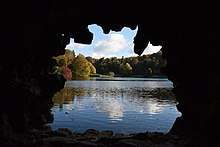Wiltshire
Wiltshire is a large, mostly rural county in the eastern part of the West Country of southern England. Wiltshire features large areas of rolling chalk downland and grazing farmland, including Salisbury Plain, a large expanse of downland of which part is famously used as a training area by the British Army. For the visitor to the area, Wiltshire is probably most significant because it contains several important Neolithic period monuments, including the world famous stone circles at Stonehenge and Avebury, and the former settlement of Old Sarum. The county also offers an selection of fascinating towns and villages, as well as embracing the southern parts of the picturesque Cotswolds region.

Cities, towns and villages
Towns
- 🌍 Amesbury
- 🌍 Bradford on Avon
- 🌍 Chippenham – a fast growing community, the third largest town in Wiltshire
- 🌍 Corsham
- 🌍 Devizes – a bustling market town with a heady brew of heritage and shopping. Nearby Caen Hill Locks
- 🌍 Malmesbury – town known for its historic abbey, one of the few English houses with a continual history from the 7th century through to the Dissolution of the Monasteries
- 🌍 Marlborough
- 🌍 Melksham – the fifth largest town in Wiltshire
- 🌍 Swindon – if you look past its sheer ugliness, it offers exceptional industrial heritage and a festival for every occasion
- 🌍 Trowbridge – the county town and administrative centre, the fourth largest town in Wiltshire
- 🌍 Warminster
- 🌍 Westbury – home to one of England's most famous hillside white horses
Villages
- 🌍 Avebury — a village surrounded by the largest neolithic stone circle in Europe
- 🌍 Box — site of the famous Box Railway tunnel and home to musicians Peter Gabriel and Midge Ure
- 🌍 Bratton – site of Bratton Castle (or Camp) an Iron Age hill fort
- 🌍 Castle Combe (pronounced coom) – a small pretty village north west of Chippenham
- 🌍 Cricklade
- 🌍 Lacock – a village dating back to the 13th century, owned almost in its entirety by the National Trust, site of Lacock Abbey and the William Fox-Talbot museum
- 🌍 Pewsey – a large village with a main line rail station
- 🌍 Wilton – a medium sized village to the west of Salisbury
- 🌍 Wroughton – a large village on the road between Swindon and Avebury
Other destinations
- 🌍 Stonehenge – the world's most well known prehistoric monument
Understand
Get in
By train
Great Western Railways serves the north of county (Chippenham, Swindon) to and from London Paddington, Bristol, Cardiff and Cornwall. South Western Railway serves destinations including Salisbury and Tisbury in the south on their line between Exeter and London Waterloo.
By car
The M4 serves Swindon and the north, while the A303 is the main trunk road further south, passing (controversially) right next to Stonehenge.
By plane
Wiltshire has no airports. The closest major options are probably Bristol, Southampton, and London Heathrow or Gatwick.
Get around
The train services listed in "Get In" link some of the bigger towns. Beyond that, like the rest of rural England, car is the best way of getting around, as public transport comes in the form of buses with generally limited coverage and low frequency, not to mention a confusing proliferation of operators. The Connecting Wiltshire website lists routes and timetables for those up for the challenge.
See

- 🌍 Longleat, near Warminster, BA12 7JS (Follow the brown tourist signs once you get close), ☎ +44 1985 844400. Elizabeath stately home, with safari park.
- 🌍 Silbury Hill, Marlborough. prehistoric artificial hill near Avebury, the tallest in Europe.
- 🌍 Stourhead, near Mere, BA12 6QD, ☎ +44 1747 841152, e-mail: stourhead@nationaltrust.org.uk. Palladian stately home with 1,072 hectare (2,650 acre) landscape garden, particularly famous for colourful foliage in autumn.
- The White Horses of Wiltshire. White horses created by removing the grass on hills to reveal the white chalk underneath. Most are a few hundred years old, although the Uffington White Horse is at least 3,000 years old.
Do
Eat
Drink
Stay safe
Go next